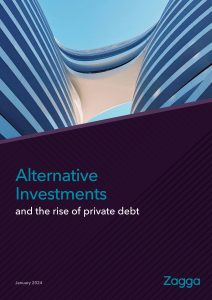Shares, bonds and cash are the three traditional investments. Everything else – from rental property to cryptocurrency to stamp collecting – falls into the category of ‘alternative investment’. The alternative investment category covers an enormously wide range of assets, including:
|
|
|
|
Private equity/venture capital, such as buying a stake in a start-up | Private debt, for example, peer-to-peer lending | Real estate, including commercial building syndicates | Commodities, such as gold and oil |
Although most New Zealanders will not be familiar with the term ‘alternative assets’, many Kiwis are already invested in alternatives. For example, they might own residential investment properties, or shares in a private investment fund.
The growth of alternative investments and private debt
Alternative investments have been around since the 1850s[1], but became considerably more popular after the global financial crisis of 2008. Growth accelerated as interest rates stayed low for the next decade, leading investors to search for superior returns as a way to smooth out volatility and inflation affects. Technology has also helped – digital trading platforms have made it easier and more affordable for individuals to invest in a wide range of assets.
Despite rising interest rates, the enthusiasm for alternative investment does not seem to be abating, and the search for relatively safe alternatives with better-than-sharemarket returns continues.
Global alternative assets under management (USD)[2]
2015 $6.91 trillion | 2021 $13.7 trillion | 2027 forecast $23.3 trillion |
The rise of private debt investment
Alternative investment has been increasing across various asset types, and one of those is private debt. This the category into which Zagga loans fall.
Private debt covers a range of non-bank lending, including peer-to-peer loans, private loans to businesses, and subprime lending. After the global financial crisis, new regulations were introduced for banks which limited their ability to lend as freely as they had previously done. Private lenders stepped in to fill the void, leading to the development and growth of private debt investment.
Private debt is the third most popular alternative investment asset, behind private equity and venture capital[3]. Private debt investments, like traditional fixed income investments such as term deposits, pay a regular return. However, the returns tend to be higher with private debt to compensate investors for the relatively higher risk.
Like alts more generally, the popularity of private debt investing has been on the rise globally, as digital platforms now allow for a wide range of non-bank lending, accessible to a much wider audience than ever before.
Total private debt market (USD)[4]
2020 $875 billion
| 2023 $1.4 trillion
| 2027 forecast $2.3 trillion
|
Private debt is popular because it provides investors with diversification, access to assets they couldn’t otherwise invest in, and higher returns when compared to stocks and bonds.
READ PART 2 HERE
or




